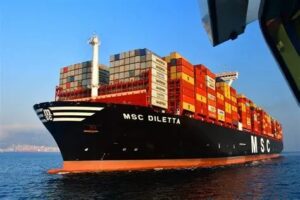A few weeks ago, the ultra-large container ship MSC Diletta docked at Ghana’s Tema Port to much fanfare. News headlines declared, “Ghana makes history!”, praising what was described as a remarkable feat of maritime expertise by the country’s marine pilots.
The reports lauded Tema Port’s technical capabilities and concluded that the docking reinforced its readiness to handle some of the largest vessels in global trade, a milestone achievement for Ghana’s maritime industry.
Indeed, the excitement was understandable. The MSC Diletta is a maritime giant: 400 meters long, 61 meters wide, and capable of carrying 23,964 twenty-foot equivalent units (TEUs). The safe and incident-free docking was no small feat, and port authorities were justifiably proud.
But this was not the first celebration of its kind and certainly not the last. Just over a year earlier, in January 2024, the arrival of another large vessel, the Maersk Edirne (366 meters long, 13,676 TEUs), was similarly hailed as a “historic milestone.” At the time, port officials and Meridian Port Services (MPS), which manages Tema Port’s Terminal 3, touted the port’s expanded infrastructure and capacity.
The MPS CEO noted: “We have deployed eight cranes on board this ship alone. Not many ports in West Africa have eight cranes, let alone the capacity to deploy them on a single vessel. The infrastructure here is built to handle vessels of this size and even larger.”
The reports concluded: “the successful docking highlights not only the technical expertise of Ghana’s marine pilots but also the readiness of Tema Port to accommodate ultra-large container ships…. this accomplishment marks a significant stride in Ghana’s maritime industry and reinforces Tema Port’s position as a premier shipping hub in West Africa, capable of handling some of the largest vessels in global trade.”
Celebrating large vessel arrivals is understandable, but it risks becoming a distraction from more urgent priorities. The true test of maritime progress does not lie in which ships we can dock, but in whether those ports serve national development, empower local economies and anchor regional trade. West Africa stands at the crossroads of global maritime shifts, geopolitical, economic and environmental ones. Whether the region becomes a sovereign actor or a glorified transit stop depends on the choices its leaders make now.
A floating spectacle, repeated across the coast
The excitement surrounding the arrival of MSC Diletta echoed earlier celebrations. On April 20, 2025, the vessel docked at MPS Terminal 3 to more fanfare and glowing commentary. Once again, reports proclaimed the docking as a major stride in Ghana’s maritime development, cementing Tema Port’s position as a leading shipping hub in the region.
But the spectacle wasn’t unique to Ghana. Just two days after departing Tema, the MSC Diletta docked at Lome Port in Togo on April 23, and was scheduled to call at Abidjan by April 28 before returning to Singapore by late May. The ship forms part of MSC’s Africa Express service—a dedicated route from Asia that connects four West African ports: Tema, Lome, Abidjan, and Pointe Noire. The celebratory language surfacing across these ports, often lauding the same vessel, is less a reflection of regional cooperation and more a sign of intra-regional competition for maritime hub status.
This trend isn’t new, when the Maersk Edirne arrived in Tema in 2024, Maersk Ghana also seized the moment to unveil a new express service from the Far East. The company cited a 23% rise in demand for seaborne cargo transport between Asia and West Africa as the key driver, highlighting ambitions to offer faster, more reliable connectivity to the region.
When size becomes a strategy in itself
Since 2022, records show that the average vessel size on the Far East–West Africa route has grown by 50%. Shipping lines are increasingly deploying larger ships to the region, with some vessels exceeding 16 000 TEUs even before the MSC Diletta’s arrival. Notably, the MSC Diletta was reassigned from the Asia–Northern Europe service to West Africa, and replaced by a smaller vessel on that route.
But while this signals growing interest in the region, vessel size alone cannot serve as a benchmark for maritime progress. Overemphasising the arrival of “giant” or “colossal” ships risks conflating physical scale with developmental success. True progress lies not in the size of ships we can berth, but in the tangible benefits such capacity brings to local economies, trade systems, and regional integration. As Goodhart’s Law reminds us: “When a measure becomes a target, it ceases to be a good measure.” In other words, size without utility is a distraction.
Ghana’s maritime transport policy seems to focus on attracting investments to expand and modernise port infrastructure, to improve cargo throughput and thereby increase government tax revenue from imports. The progressive increase in the size of vessels calling our ports is considered a success.
But there is a better assessment. Vessel size should only matter if the resulting economies of scale benefit not just shipping lines, port operators, and government coffers but also the local shipping sector, traders, and the wider national and regional economy. Yet, even as the MSC Diletta’s docking was celebrated, shippers and freight forwarders were lamenting delays and mounting costs at Tema Port.
On April 25, 2025, barely a week after the successful docking of the MSC Diletta and before the celebratory voices faded, importers and freight forwarders at Tema Port were “raising the alarm over growing financial losses as persistent delays in clearing goods continue to cripple their operations.” The Ghana Institute of Freight Forwarders added its voice to the growing concerns by calling for a comprehensive review and stating that such a review is critical to eliminating inefficiencies and ensuring faster clearance of goods to protect the interests of importers and the national economy.
This was not an isolated grievance. In September 2024, reports emerged that several trade associations from the logistics and shipping sectors organised a peaceful demonstration against what they described as exploitative practices by foreign shipping lines operating in the country. According to their reports, these practices have stifled growth in Ghana’s shipping sector, undermined businesses, and crippled the financial health of many supply chain actors.
The complaints range from allegations of demurrage charges applied during weekends and holidays, illegal and arbitrary fees, costly service delays, and the increasing encroachment of foreign shipping lines into local businesses such as ship agency and customs brokerage. A major source of frustration was the dollarisation of shipping fees. These issues have culminated in a pending lawsuit, filed by a local shipper against several foreign shipping lines and their agents.
Clearly, the benefits of size or scale are not reaching local cargo interests and their agents. The economies of scale being pursued by multinational shipping lines, port and terminal operators in the region are limited in the efficiencies they create. The CEO of MSC pointed out that “the impact of larger vessels calling the port on freight will be marginal.”
This is the consequence of mistaking size for strategy. When vessel or port size becomes more than just a metric and it is turned into a proxy for success, it loses its analytical value. In such cases, the focus on scale, can obscure missed opportunities for real growth, commercial viability, and regional integration. A measurement like ship size is only useful when it helps illuminate a wider picture—not when it becomes the picture itself.
Infrastructure growth without integration
Port expansion and modernisation projects in West Africa aimed at addressing congestion, accommodating larger vessels and dealing with growing container traffic began over a decade ago. As far back as 2018, a US International Trade Commission briefing noted that container trade in West Africa had doubled over ten years, reaching nearly 5 million TEUs, outpacing every other region globally.
The same briefing explained that rising incomes were leading to increased container traffic and fuelling congestion, which was exacerbated by shallow berths and outdated infrastructure. To cope, many ports turned to foreign terminal operators like Bolloré (France) and APM Terminals (Denmark), who now handle three-quarters of the region’s container traffic. A World Bank report acknowledged that some ports, such as Cotonou (Benin), did experience notable productivity gains after foreign operators took over. Cotonou’s container productivity rose by 48.3% in a single year.
But these gains have come at a cost. Increased market concentration has led to higher operating expenses, reduced competition, and limited benefits to the local maritime economy. As the World Bank cautiously put it: while foreign investment has helped expand port capacity, “critical gaps remain.”
Infrastructure upgrades have continued apace. In Ghana, Phase 2 of the $1.5 billion Tema Port Expansion Project is underway, set to increase container capacity at Terminal 3 from 2.5 million to 3.7 million TEUs annually. MPS, the terminal operator, is a joint venture between APM Terminals, Bolloré, and the Ghana Ports and Harbours Authority.
In Togo, Terminal Investment Limited (MSC’s terminal operator) holds a 35-year concession at Lome Port, with $380 million invested so far and throughput capacity projected to rise to 2.7 million TEUs.
In Côte d’Ivoire, APM Terminals and Bolloré have expanded Abidjan Port’s second terminal. Senegal’s $827 million Port of Ndayane is under construction with Dubai Ports World, and Nigeria’s Lekki Port, partly owned by China Harbour Engineering, is targeting an annual capacity of 2.5 million TEUs.
These developments, though ambitious, share a common flaw: they are fragmented, uncoordinated, and heavily reliant on the same pool of foreign capital and operators. Rather than fostering regional collaboration, they pit West African ports against one another in a race for hub status. As a result, Abidjan, Tema, Lome, and Lagos are now celebrating the same vessel arrivals in a carousel of self-congratulation, each declaring itself a future hub.
A new map of maritime trade
Apart from port infrastructure upgrades, recent global events have provided fresh impetus for the scaling up of services into West Africa by multinational shipping lines. Chief among these was the Red Sea crisis, which forced vessels to avoid the Suez Canal, one of the world’s most critical shipping arteries linking Europe and Asia. By January 2024, United Nations Trade and Development (UNCTAD) estimated that the volume of trade passing through the Suez Canal had dropped by 42%.
In response, shipping lines turned to the Cape of Good Hope as an alternative route. This long detour which was once dismissed as uneconomical is now becoming a strategic option. Initially, there was hesitation. As Reuters reported in December 2023, companies were wary of red tape, congestion, and poor facilities at African ports. But as attacks escalated and passage through the Suez became untenable, that caution gave way to a more pragmatic outlook.
Maersk, for instance, noted in 2023 that the resilience and consumption growth in African markets were now key factors in routing decisions. The Head of Market for the Indian Subcontinent, Middle East, and Africa was quoted as saying: “We are witnessing rapid growth in the African markets… our ambition is to deliver a competitive advantage to our customers and be future-ready.”
That shift in tone is significant. What was once a backup route is fast becoming a vital trade corridor. With Africa’s population projected to reach 2.5 billion by 2050 accounting for nearly 28% of the global total and West Africa home to roughly a third of that, the region’s maritime significance is growing fast.
Africa’s economy is growing faster than the global average. According to the African Development Bank’s latest outlook, real GDP growth on the continent is expected to average 3.8% in 2024 and 4.2% in 2025 which is well above global projections. At the same time, Africa’s merchandise exports are expected to grow at 5.3% in 2024, up from 3.1% in 2023, according to Afreximbank.

Add to this the mounting environmental disruptions in global shipping. In 2023, the Panama Canal — a route that carries 5% of global trade — was severely affected by drought. Restrictions on vessel passage due to low water levels created bottlenecks that rippled across supply chains. Experts warned that as climate volatility increases, such disruptions will become more frequent and severe.
With both the Panama and Suez Canals facing environmental and geopolitical pressures, the long route around Africa is gaining relevance. As the Woodwell Climate Research Centre noted: “the only path to stabilising global shipping lies in stabilising the global climate.” But while that long-term challenge plays out, shipowners are recalibrating their logistics in the short term, and West Africa stands in the middle of that recalibration.
Green shipping: inevitable, expensive, and unfairly distributed
Not surprisingly, the shipping industry is under growing pressure to decarbonise. At the recently concluded 83rd session of the IMO’s Marine Environment Protection Committee (MEPC), new regulations were adopted to meet the revised 2023 GHG Strategy. These include fuel standards aimed at reducing carbon intensity by 8% by 2030 and a credit trading scheme that could generate up to US$40 billion to subsidise green fuel adoption and fund climate projects in developing countries, many of them in Africa.
But the transition will not be smooth. Critics warn that the new rules could raise global shipping costs by up to 80% by 2050. Combined with other climate-linked market mechanisms like the EU Emissions Trading System, the financial burden on African trade, already grappling with some of the world’s highest transport costs, will only increase.
As shipping lines invest in greener vessels and look for alternative fuel supplies, they will inevitably pass compliance costs onto cargo owners. In this context, West Africa must not just be a passive recipient of these changes, it must shape them. A green transition without local capacity-building will only deepen dependency and inequality.
Taken together, these global disruptions, trade trends, and climate policies are driving the scaling-up of operations by multinational shipping lines, not just in Ghana, but across the West African coastline. Yet while foreign operators, terminal authorities, and governments are beginning to reap the benefits of these shifts, local players remain on the margins.
The obstacles to building a truly localised maritime economy are well known. Policy incoherence, weak regulatory enforcement, bureaucratic hurdles, underdeveloped local industries, a misperception of Africa’s maritime risk profile, trade imbalances, currency volatility, and fragmented infrastructure all continue to limit the region’s ability to seize the moment.
What’s missing is not opportunity, but coordination and vision. With the global map of maritime trade being redrawn in real time, West Africa can no longer afford to celebrate docking feats without asking: Who benefits? Who owns the system? And what legacy are we building?
Despite the presence of national maritime policy frameworks, some quite comprehensive, many West African countries appear focused primarily on attracting foreign direct investment into port expansion. The goal is often narrowly defined: increase container throughput, boost government tax revenue, and win subregional hub status.
But in pursuing this strategy, countries are acting in isolation, without subregional or continental coordination. The infrastructure investments are being financed largely by international capital tied to global shipping conglomerates, and the most commercially lucrative sections of these ports are now operated by affiliates of those same companies.
The result is a clustering of competing mega-ports in the same region, each chasing the same ships, each claiming hub status, and each celebrating the same vessel calls, as if in competition for prestige rather than purpose.
The missing middle: a local maritime industry
The situation presents a contradiction. While shipping lines are taking advantage of the economies of scale to improve their margins and African governments are benefiting from increased tax revenue, there remains critical gaps in the local shipping industry. Those critical gaps also include the absence of a thriving fit-for-purpose local shipping sector centred around short-sea or coastal and inland waterways shipping.
Short sea shipping is a completely different segment of the shipping business. It distributes cargo delivered to regional centres or primary, deep water ports, and provides a national or regional port-to-port service as a more efficient alternative to land based transportation such as road and rail. The ships and infrastructure required to carry out short sea shipping are smaller and less costly. The true measure of hub status is the number of direct, effective connections a primary port has with the secondary or spoke ports or harbours within the region. Such a hub port must by definition have facilities for docking, refuelling and restocking the numerous short-sea vessels sailing into and out of it.
Arguably, none of the ports in West Africa: Lagos, Tema, Lome, or Abidjan, can make that claim today.
UNCTAD and the United Nations Economic Commission for Africa (UNECA) project that when the African Free Trade Continental Area (AfCFTA) Agreement is fully implemented, Africa will be needing about 135 new ships at an estimated cost of US$4 billion. These ships will connect ports in the region, moving materials, goods and people intra-Africa, connecting production or resource centres to markets within the continent efficiently. This will boost intra-African trade which is stagnating at around 15% of Africa’s total trade. In turn, a successful increase in that trade will shorten Africa’s supply chain for several goods (with the resultant emission reduction benefits), reduce Africa’s import dependency, particularly on food, and thereby improve its balance of trade. Such a localised shipping sector will create new jobs for local financiers, lawyers, surveyors, classification societies, insurers, seafarers, ship brokers, ship managers, chandlers, bunker suppliers, repair and maintenance yards, ship recycling facilities, among others.
But this critical gap and opportunity appears to have been unidentified or worse, ignored and left open to multinational shipping lines and their affiliates to fill. By means of their vertical integration policies, multinational carriers are moving their shipping activities which already encompass terminal operations and local ship agency further into feeder services, inland transportation, logistics, container weighing, warehousing and storage, comprehensive cargo insurance coverage, and others in which locals may very well possess the comparative advantage.
Worse still, the port or land side incursions by multinational carriers are neither inuring directly to the benefit of local shippers, nor are their impact on the wider local economy being felt. Their cost of sales to the local market, the absence of real competition, and their unregulated strategic alliances for market dominance are together, prohibitively increasing the cost of shipping through the region’s ports. Unsurprisingly, the recent protests by local shippers and their agents against unjustifiable demurrage charges, container administrative fees and other such land-side charges and taxes, including the numerous, hefty surcharges, point to the shipping lines, the inefficiencies of the port and terminal operators, and the unrelenting tax demands of governments as the causes.
A policy vision for maritime sovereignty
To plug the local maritime needs gap, policy shortfalls must be addressed. Existing national maritime policies aimed at developing the local maritime transport sector have proven ineffectual. National policies have proven too fragmented, reactive, and state-centric, often excluding private sector input from an industry built on commercial logic. Also, those policies are invariably informed by a public sector ethos in both their formulation and implementation, and unfortunately leaving out the needed private sector input in an industry driven largely by commercial considerations.
What is needed is a coordinated, continental regime—a Continental African Maritime (CAM) Corridor. This would harmonise port laws and standards, incentivise local vessel ownership with tax breaks and finance packages, and offer preferential berthing for regionally flagged vessels. It would also anticipate climate imperatives by supporting green ship procurement, solar- or battery-powered port equipment, and low-carbon fuel infrastructure.
Even before full policy alignment, port authorities across the continent could act collaboratively, streamlining cargo clearance systems, adopting a digital single-window framework, and coordinating operations. In doing so, they would not only lower costs and improve efficiency but also diversify revenue streams and stimulate local trade.
Additionally, the policies must take account of the international efforts to decarbonise shipping, to build a green local shipping sector made up of alternative fuel powered vessels; battery or solar powered port equipment, vehicles and generators, and production and fuelling points for alternative fuels.
Fixing the foundations: from bureaucracy to coordination
Weaknesses in maritime policy and regulation often come from administrative bottlenecks and operational inefficiencies. The persistent delays and spiralling land-side costs, never mind the disproportionately high freight rates and surcharges Africa endures due to mischaracterised risks and unregulated anti-competitive practices, stem in large part from a public sector ethos ill-suited to the commercial realities of shipping.
In places like Ghana, shippers and their agents continue to decry these challenges. A bloated administrative structure, compounded by bureaucratic red tape, overlapping agency mandates, and physical inspections more focused on revenue extraction than facilitation, add layers of inefficiency. Equipment failures and outdated port systems further widen the costly gap between contractual and actual cargo delivery.
These critical inefficiencies must be resolved to realise a truly continental, efficient, and resilient maritime transport sector. Digitalisation is key. Single-window systems aimed at integrating and streamlining cargo clearance must be scaled and expanded to reduce land-side costs, deter corruption, and improve overall productivity. A continental cargo clearance digital system, commercially procured and collectively adopted by African ports, could bypass bureaucratic inertia and serve as a key enabler of the CAM Corridor policy.
Finally, a uniform continental tax instrument could help mobilise local capital to fund Africa’s maritime ambitions. A modest levy per TEU on non-essential consumer imports could generate the estimated US$4 billion needed to build Africa’s 135 new ships and the accompanying infrastructure for a fit-for-purpose, locally owned shipping industry.
Rethinking progress in West Africa’s maritime sector
Finally, the above factors considered together, must form the foundation for determining the success or otherwise, the challenges, and the opportunities of Africa’s maritime transport sector. Singling out the size of vessels and ports leads to a narrow, skewed or disjointed assessment of the condition and prospects of Ghana’s for that matter, the West African sub-region’s maritime transport sector.
And as this article nears completion, another celebration of size is underway. On April 26, 2025, the MSC Turkiye, an ultra-large container vessel over 400 meters long with a capacity exceeding 24,000 TEUs, arrived at Tema Port. Local media hailed her as “a floating city of commerce,” her docking witnessed by Ghana’s dignitaries and leaders of industry. Another milestone, another headline, another round of applause.
But while the applause echoes across the coast, perhaps it’s time to pause. To ask harder questions. And to reflect, as two African proverbs wisely remind us: “If there were no elephant in the jungle, the buffalo would be a great animal,” and “no matter how full the river, it still wants to grow.” This serves as a reminder that inflated comparisons may blind us to what actually matters: building what we need, not what others applaud.
The author, Mr. Stanley R. K. Ahorlu, is a maritime entrepreneur and lawyer. He is the President of the Ghana Chamber of Shipping; founder and CEO of Prime Meridian Docks Ghana Limited and Ahorlu Marine Limited. He can be reached at [email protected].










